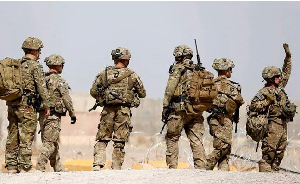Health News of Thursday, 3 July 2014
Source: The Chronicle
Assault on health staff is against the law - Dr. Awoonor-Williams
The Upper East Regional Health Directorate is worried about incidents of assault on health professionals in the region, which have the propensity to affect the morale of health workers and the quality of health care delivery.
Assault on Nurses
According to the Regional Health Director, Dr. Koku Awoonor-Williams, health staff have been beaten up by some community members while on duty. He cited an incident in Kajelo in the Kassena-Nankana area, where a nurse was severely beaten up by a community member, and in the process, had her right eye damaged. He said the perpetrator beat up the nurse because the she had given him drugs he perceived were less than what he should have been given. The Health Directorate was currently seeking high level treatment for the nurse.
In a similar incident, another nurse was beaten up in the Bawku West District, because he was treating a woman whose husband had beaten her up and asked the nurse not to treat her. The Director described these cases as serious and which bordered on being against the law, and gave the assurance that his office would ensure that the perpetrators are dealt with according to law.
Dr. Awoonor-Williams raised these concerns during a press briefing on newborn care activities in the region. He said, sometimes, there were a lot of outrageous statements about the health delivery system in the region’s hospitals and health centres, but nothing was being said about the negative things that happen to health staff.
“When it goes against the health sector, people are quick to speak, but when it goes against them, we hardly hear any support from the media. Our nurses are being beaten in the communities, and nobody talks about it, but when a nurse shouts on a patient, then it’s all over the place,” the Director lamented, and called to the media to report on such matters, and also educate the people.
Speaking on newborn care activities in the region, the Director said the period when much concentration was on the survival of a mother during delivery, to the neglect of the baby, was over, and that the time had come for the same level of concentration to be given to mothers as well. He explained that because more concentration was given to mothers than babies, that was why progress was made in achieving lower mortality for maternal health.
“Because, when a woman goes to a facility, everybody focuses on the mother. The mother should be alive. If the baby is delivered, it is put somewhere, and, for instance, if the mother is bleeding and is in distress, everybody is running around and concentrating on the mother, and if the baby passes on, everybody is like it’s ok, at least, we thank God the mother survived. We have passed that bridge where we over-concentrated on the mothers. Now we want to concentrate on both the mother and the baby, so that the mother can go home with the baby”.
To further buttress his explanation, Dr. Awoonor-Williams said the region was doing very well, and, in fact, was the lowest among the ten regions of Ghana on maternal deaths issues. “That is not to say mothers are not dying. Mothers are still dying, and our goal and our wish is that no mother should die while giving life,” he stressed. He said even though the region had the lowest maternal mortality rate, the Health Directorate was working towards getting zero maternal mortality.
Dr. Awoonor-Williams admitted that when it came to child mortality, the region was not doing well at all, stressing that if the mother survives, the baby must also survive. According to him, within the whole ambit of child mortality, it had been observed that mortality under five, otherwise referred to as neo-natal mortality, was 40 to 50%.
He said if the Health Service could address this, based on the percentage contribution of neo-natal mortality, they would have been making so much progress. He also said under newborn mortality, a lot of the issues were not within the control of the health professionals, but rather, they were about the communities, cultural, behaviour, and attitudes, and all these combined, must be addressed at the community level.
Unfortunately, he said, his staff could not be in every community. He was particular about negative cultural practices that were inimical to newborns, such as keeping children for five or more months after their deliveries, because landlords were not present, as well as the concoctions that women were forced to take during delivery, the kinds of herbs that they smeared on the umbilical cord, and the kinds of concoctions mothers gave to their babies to drink, for one reason or the other, such as babies not passing stool, and the belief that the first breast milk was not good for newborn babies after delivery.
Women are also locked up in rooms during delivery to deliver alone. This was to prove to their husbands that they were faithful wives who did not have affairs outside of their marriages.
Role of the Media
Dr. Awoonor-Williams, therefore, acknowledged the role of the media, especially local private radio stations, in educating the people to desist from some of these outmoded cultural practices that posed serious threats to newborn babies. He announced that in order to improve on newborn care, the Ghana Health Service and Ministry of Health had established in two of the region’s major hospitals – the Regional Hospital in Bolgatanga and War Memorial Hospital in Navrongo – Neonatal Intensive Care units for the first time in the history of the region.
He explained that Neonatal Intensive Care units are to make kids who were very sick at delivery survive by hi-tech medical services. The conditions of such babies included babies who were jaundiced severely and underweight. The Director hoped over the next two years, these hi-tech medical services would be scaled up to cover the Bongo, Zebilla, and Sandema districts hospitals.
Dr. Awoonor-Williams applauded the media in the region for the wide coverage during the launch of this year’s Child Health Promotion Week, which took place in the region. He described the week as one of the major interventions towards child survival, during which period, the GHS/MoH provided comprehensive child health services to all kids in Ghana. He said one of the ways his Directorate could improve upon community information relationship was to provide information cinema vans that would move to communities and show movies and films on major health activities that would impact positively on the communities.
He hinted that his Directorate was working on a proposal in acquiring a cinema van with a public address system for community-based health education activities. He was optimistic the proposal would go through, and appealed to local radio stations to allocate some airtime to support the Directorate’s educational programmes.
Dr. Awoonor-Williams also touched on a number of health issues in the region, including the following: Teenage pregnancies: Upper East Region has the highest rate of teenage pregnancies in the country. Recently, statistics available at the Nabdam District Girl Child Education Unit of the Ghana Education Service revealed that since the beginning of the 2013-2014 academic year, a total of 43 teenage school girls were pregnant.
The Health Director described the situation as “we have babies getting pregnant.” He said the situation was most awful in the Bongo District, and added that these were serious health problems which the hospitals alone could not handle without the involvement of the media, religious and traditional leaders, and parents. Stunted growth: Dr. Awoonor-Williams said the region again has the highest rate of stunted growth and malnutrition in the country. “So you have stunted mothers giving birth to stunted babies. Before the child is born, he is already stunted.
Stunting is a chronic disease,” he said.
But what could possibly be responsible for some of these conditions? The Health Director believed it was due to ignorance, and called on the media to support in educating the people about the dangers of such issues. Ambulance services: He observed there were so many communities in the region where ambulance services could not reach due to the general organisation of the service. He suggested that there was the need for the whole referral system to be redesigned to meet the current needs of the people. The road network linking communities to hospitals was generally terrible, such that no ambulance could travel on such roads to save lives.
It was against this background that Dr. Awoonor-Williams, with the support of his administrators, designed what was now termed as “Appropriate Technology” as ambulance services.This is the modification and introduction of tricycles as ambulances to provide similar services, which innovation, the Director said, had saved many lives. He said in areas where this innovation was introduced, high-class ambulances could not reach there, especially in the rainy season.
The Regional Coordinator of Newborn Care, Rofina Asuru, revealed that from 2010 to 2013, the region recorded 143 maternal deaths, as against 552 neonatal deaths within the same period. As part of measures to curb this frightening trend, the Coordinator said, since 2013, 112 health staff, comprising doctors, midwives and general nurses, had been trained on how to detect illnesses in newborns using a colour coding.










